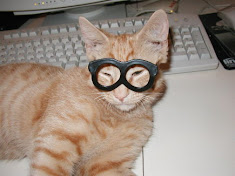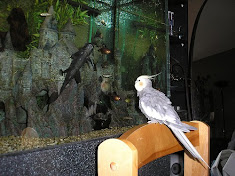I don’t know why I thought I could get away with it.
When my cat “Bear” jumped onto my lap expecting his morning petting session, I wondered if THIS time I could get away with reading the newspaper while giving him a few off-hand, preoccupied strokes.
“Heh, heh”, I thought. “I’ll start by giving him my full attention but then I’ll sneak my paper in when he’s not looking.” I “chucked” him under the chin while stroking him from head to tail, and he began rolling in ecstasy.
When he turned his back on me, sprawling on his stomach, my moment came. Quickly, I reached for the newspaper with my right hand. Continuing to pet Bear with my left, I opened it to the front page.
Bear put his ears back.
“Uh, oh”, I said to myself. “But wait…he can’t see what I’m doing. How does he know that I’m cheating?”
But he knew.
Bear tolerated it for a few moments; his ears laid back, his tail thrashing. Suddenly he leaped from my lap and lay down on the floor. After a few minutes of washing, he stared at me with an accusing expression.
I’d spoiled HIS morning petting session with my own selfishness and he was clearly letting me know the error of my ways.
Do Cats Think?
Cat owners may be the only pet lovers who sincerely believe their pets think. It won’t be the first time that a cat owner has the distinctly uncanny feeling that not only does his beloved cat think, but that he is being manipulated by her.
Veteran cat owners have noticed:
In short, the cat “owner” always has the vague feeling that he is somehow being conned, but is never sure exactly in what way.
What Do We Mean By The Word "THINK"?
Answers.com defines the ability to think as “To exercise the power of reason, as by conceiving ideas, drawing inferences, and using judgment.”
Arguably, it is the power of reason, the ability to conceive ideas, use judgment and put the results into action that has placed Man at the top of the food chain. In other words, Man dominates his/her environment because of his/her ability to think.
The Cat Brain and Cat Behavior
Cats are often used as experimental animals because the feline brain is structured like the human brain. The question is, however, do these similarities result in similar cognitive processes, i.e., can a cat actually assemble information, reason things out and make decisions?
The cat’s lack of cooperation with trainers has been taken either as a high degree of intelligence on the part of the feline (either too smart to do what a human tells her to) or a low degree (too stupid to be amenable to training).
Cat lovers usually opt for the former having the distinct impression that they, not their cats, are being trained.
Can Cats Use Tools?
A writer for About.com, J. Justin Lancaster, reported that his cat Sasha had discovered a way to wet down her dry cat food by carrying a cotton hair “scrunchy” to the toilet to wet it and subsequently using it to drip water on her food. This may be the most sophisticated use of tools ever observed in the non-human animal kingdom.
On the other hand, most cat owners observe that a cat, when confronted with an obstacle barring her from a goal, will never move the obstacle out of the way. If the obstacle falls out of the way the cat will be momentarily surprised, but will then proceed to reach the unobstructed goal.
When finding herself again in the same situation, with the same destination blocked by the same obstacle, the cat will not knock the obstacle out of the way even though previous experience has shown that this is the best way reach the goal.
The Jury Is Out
So, the jury is either out, or “hung”, on the question of whether or not cats think.
But when my cat, without looking at me, knows that I’m not giving him my full attention, and gives every evidenced of being miffed at this, I wonder.
Why is petting him while reading the newspaper not the same thing as petting him while using my full concentration?
It doesn’t make sense unless I accept the possibility that he has thought it out. That he has decided that it is either all or nothing, and he just isn’t going accept “playing second fiddle” to a newspaper. And his conclusion is: I’d better shape up. Anything short of my full attention is not acceptable.
He is going to get a full petting from me -- or not at all.
About the Author: John Young is an editor and writer living in Southern California with his wife and pet cat “Bear”. He is author of “Your New Cat’s First 24 Hours”, http://www.yourcatsecrets.com and editor of a new ezine “The Online Cat”, http://www.theonlinecat.com .
Source: www.isnare.com
Permanent Link: http://www.isnare.com/?aid=158549&ca=Pets
When my cat “Bear” jumped onto my lap expecting his morning petting session, I wondered if THIS time I could get away with reading the newspaper while giving him a few off-hand, preoccupied strokes.
 |
| Do I Think? Yeah, and I'm Thinking I Want To Be Outside by Alexander Somma |
When he turned his back on me, sprawling on his stomach, my moment came. Quickly, I reached for the newspaper with my right hand. Continuing to pet Bear with my left, I opened it to the front page.
Bear put his ears back.
“Uh, oh”, I said to myself. “But wait…he can’t see what I’m doing. How does he know that I’m cheating?”
But he knew.
Bear tolerated it for a few moments; his ears laid back, his tail thrashing. Suddenly he leaped from my lap and lay down on the floor. After a few minutes of washing, he stared at me with an accusing expression.
I’d spoiled HIS morning petting session with my own selfishness and he was clearly letting me know the error of my ways.
Do Cats Think?
Cat owners may be the only pet lovers who sincerely believe their pets think. It won’t be the first time that a cat owner has the distinctly uncanny feeling that not only does his beloved cat think, but that he is being manipulated by her.
Veteran cat owners have noticed:
- Cats are an extremely obsessed and determined animal.
- Cats seem to contemplate things and make decisions.
- Cats choose and adopt people.
- Cats become offended and can hold grudges at insults to their dignity. Fortunately they forget them pretty quickly.
- They are embarrassed easily and seem to cover it up with nonchalant behavior.
- They are extremely independent, but want to cooperate with humans as long as this spirit of cooperation is thoroughly disguised.
In short, the cat “owner” always has the vague feeling that he is somehow being conned, but is never sure exactly in what way.
What Do We Mean By The Word "THINK"?
Answers.com defines the ability to think as “To exercise the power of reason, as by conceiving ideas, drawing inferences, and using judgment.”
Arguably, it is the power of reason, the ability to conceive ideas, use judgment and put the results into action that has placed Man at the top of the food chain. In other words, Man dominates his/her environment because of his/her ability to think.
The Cat Brain and Cat Behavior
Cats are often used as experimental animals because the feline brain is structured like the human brain. The question is, however, do these similarities result in similar cognitive processes, i.e., can a cat actually assemble information, reason things out and make decisions?
The cat’s lack of cooperation with trainers has been taken either as a high degree of intelligence on the part of the feline (either too smart to do what a human tells her to) or a low degree (too stupid to be amenable to training).
Cat lovers usually opt for the former having the distinct impression that they, not their cats, are being trained.
Can Cats Use Tools?
A writer for About.com, J. Justin Lancaster, reported that his cat Sasha had discovered a way to wet down her dry cat food by carrying a cotton hair “scrunchy” to the toilet to wet it and subsequently using it to drip water on her food. This may be the most sophisticated use of tools ever observed in the non-human animal kingdom.
On the other hand, most cat owners observe that a cat, when confronted with an obstacle barring her from a goal, will never move the obstacle out of the way. If the obstacle falls out of the way the cat will be momentarily surprised, but will then proceed to reach the unobstructed goal.
When finding herself again in the same situation, with the same destination blocked by the same obstacle, the cat will not knock the obstacle out of the way even though previous experience has shown that this is the best way reach the goal.
The Jury Is Out
So, the jury is either out, or “hung”, on the question of whether or not cats think.
But when my cat, without looking at me, knows that I’m not giving him my full attention, and gives every evidenced of being miffed at this, I wonder.
Why is petting him while reading the newspaper not the same thing as petting him while using my full concentration?
It doesn’t make sense unless I accept the possibility that he has thought it out. That he has decided that it is either all or nothing, and he just isn’t going accept “playing second fiddle” to a newspaper. And his conclusion is: I’d better shape up. Anything short of my full attention is not acceptable.
He is going to get a full petting from me -- or not at all.
About the Author: John Young is an editor and writer living in Southern California with his wife and pet cat “Bear”. He is author of “Your New Cat’s First 24 Hours”, http://www.yourcatsecrets.com and editor of a new ezine “The Online Cat”, http://www.theonlinecat.com .
Source: www.isnare.com
Permanent Link: http://www.isnare.com/?aid=158549&ca=Pets























